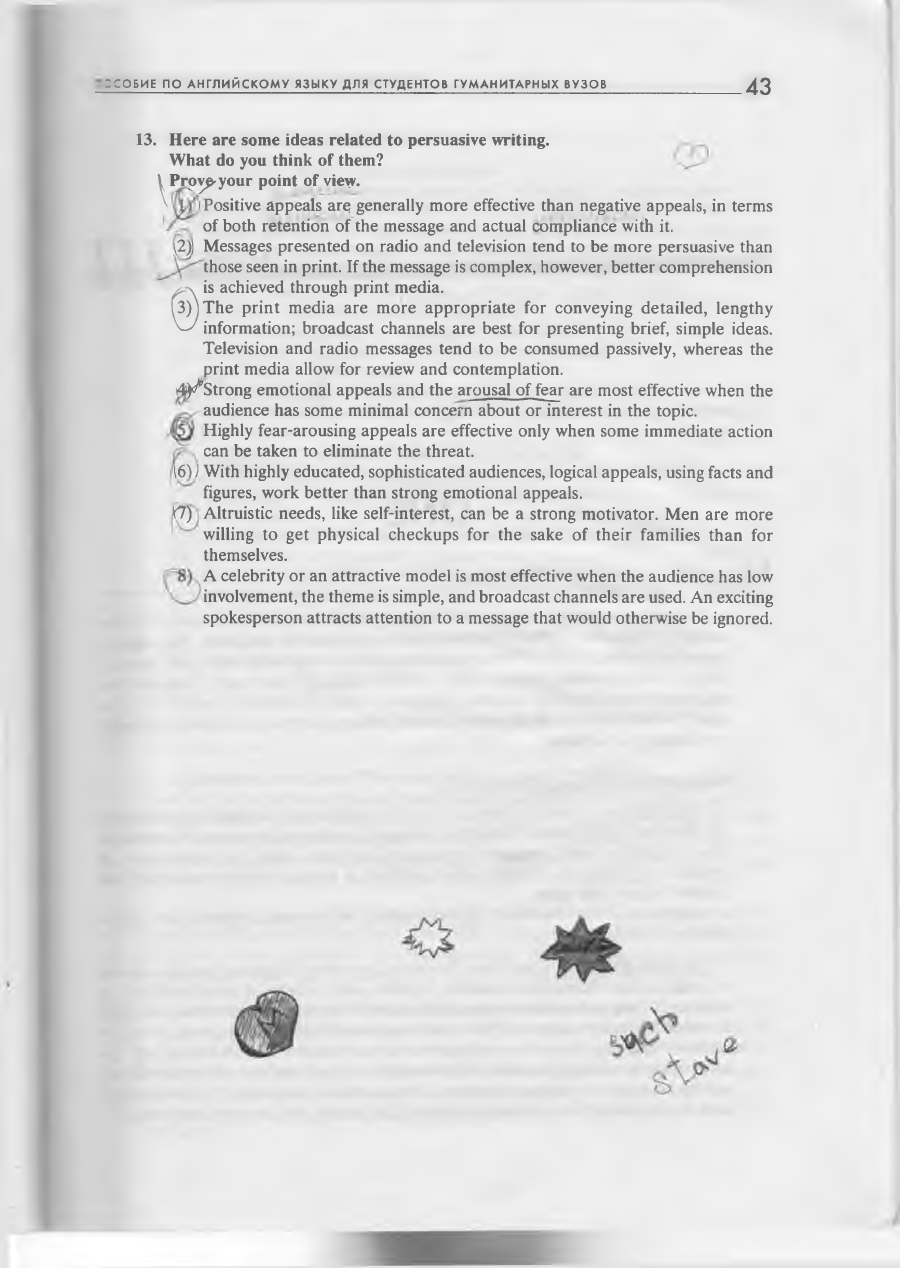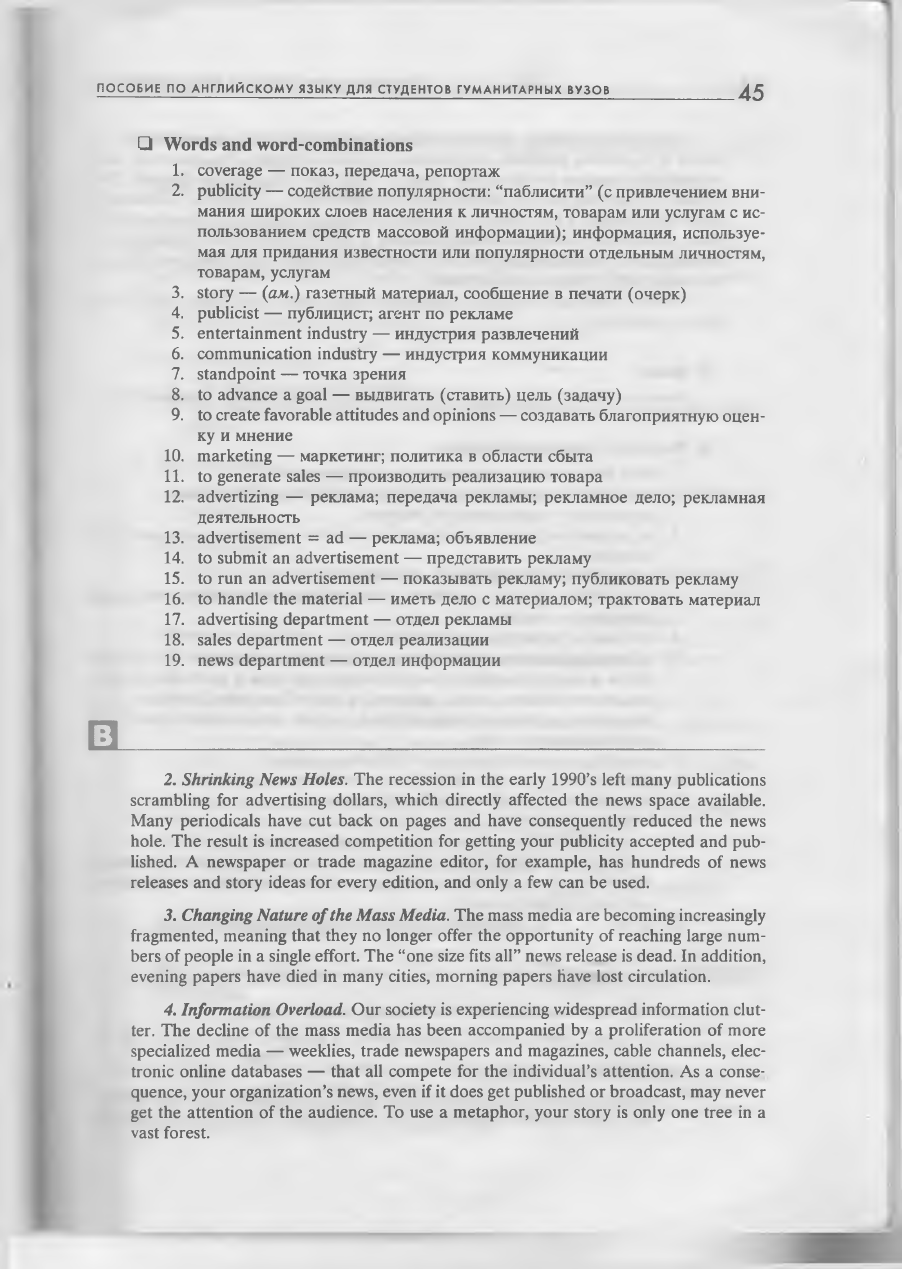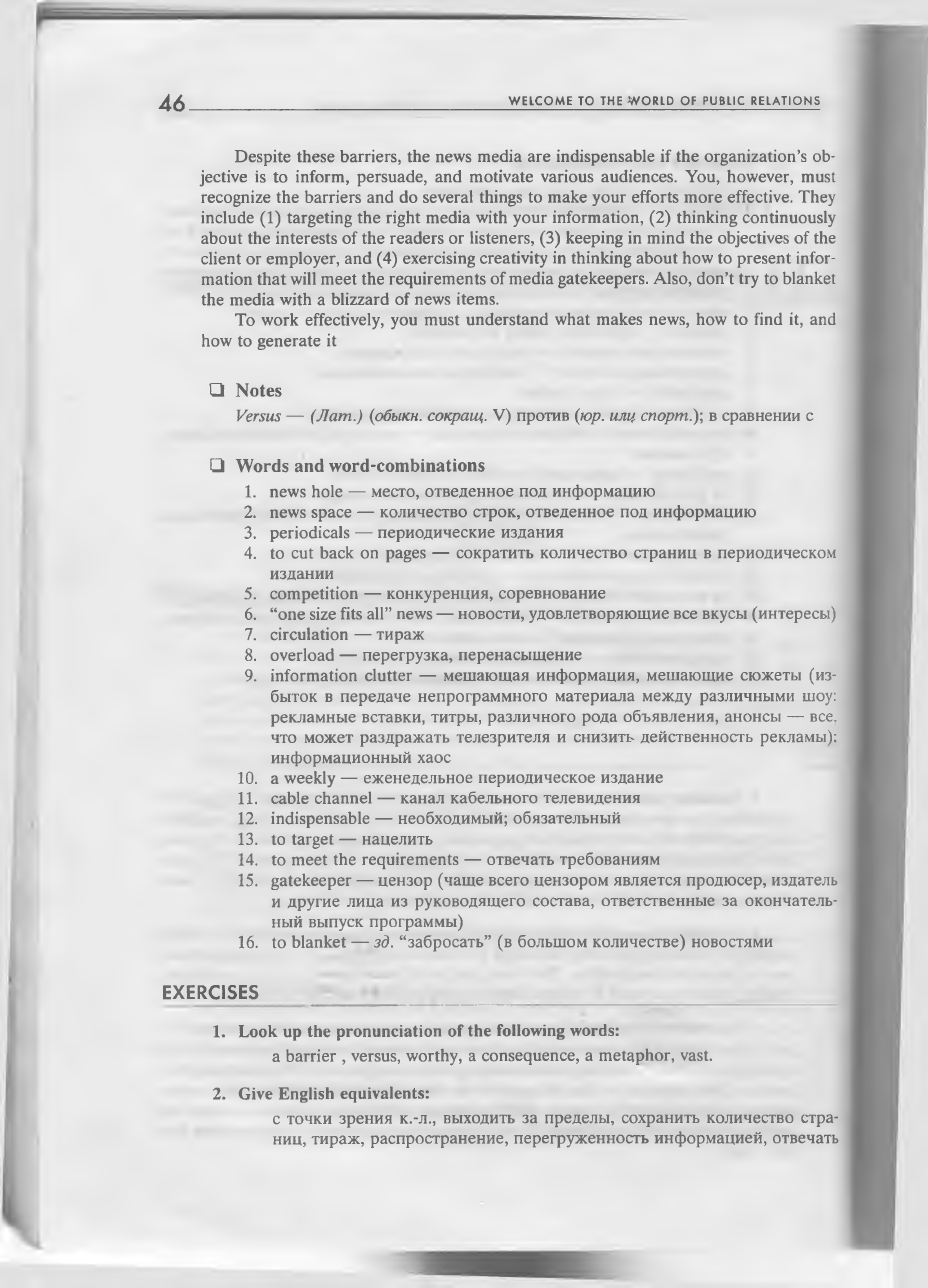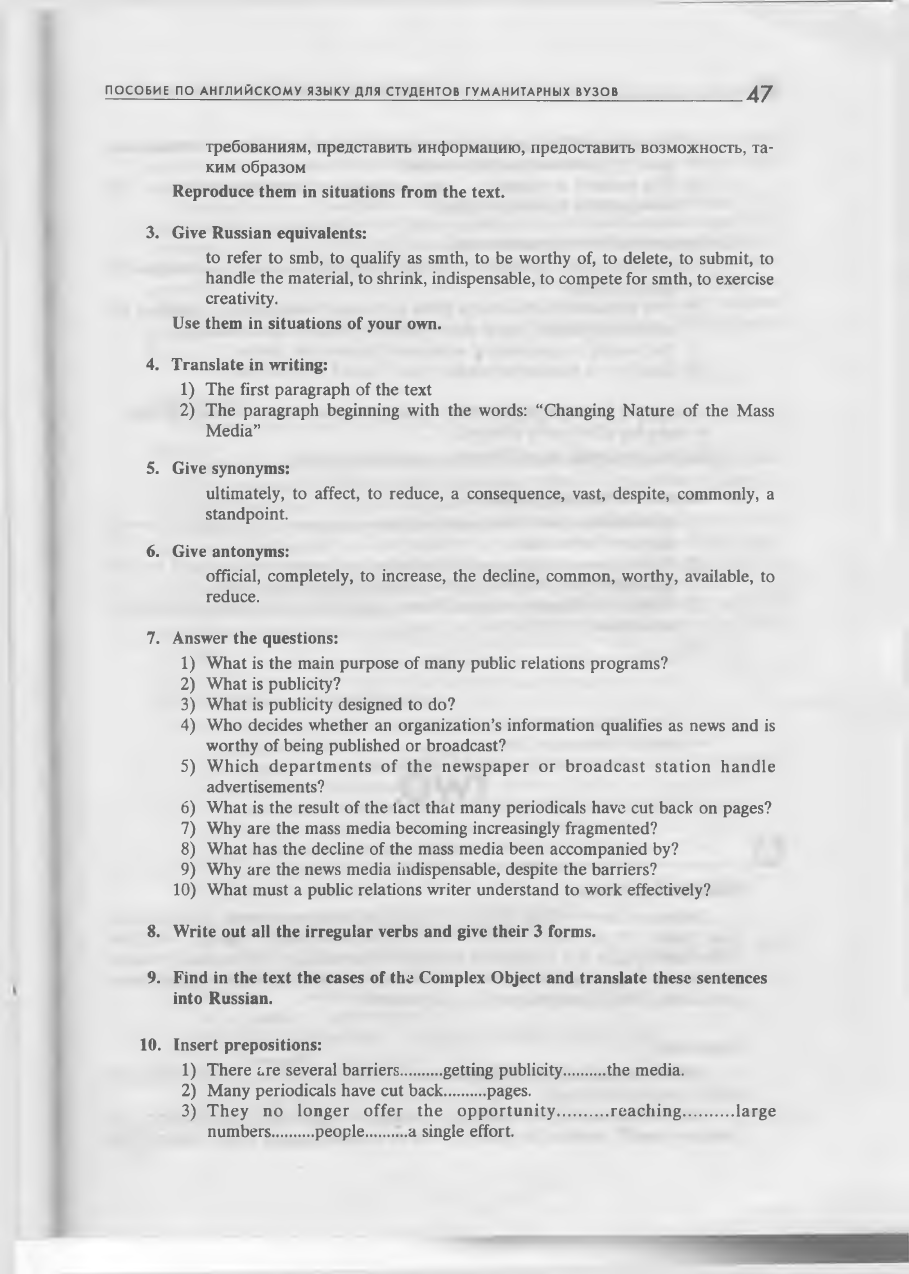ВУЗ: Не указан
Категория: Не указан
Дисциплина: Не указана
Добавлен: 01.04.2021
Просмотров: 1553
Скачиваний: 7

:
с о б и е
П О А Н Г Л И Й С К О М У Я З Ы К У Д Л Я С Т У Д Е Н Т О В Г У М А Н И Т А Р Н Ы Х В У З О В
43
\
13. Here are some ideas related to persuasive writing.
What do you think of them?
Prpyp'your point of view*
i Positive appeals are generally more effective than negative appeals, in terms
of both retention of the message and actual compliance with it.
\2j! Messages presented on radio and television tend to be more persuasive than
those seen in print. If the message is complex, however, better comprehension
®
is achieved through print media.
The print media are more appropriate for conveying detailed, lengthy
information; broadcast channels are best for presenting brief, simple ideas.
Television and radio messages tend to be consumed passively, whereas the
print media allow for review and contemplation.
4)<^Strong emotional appeals and the arousal of fear are most effective when the
audience has some minimal concern about or interest in the topic.
Highly fear-arousing appeals are effective only when some immediate action
can be taken to eliminate the threat.
\6Y
With highly educated, sophisticated audiences, logical appeals, using facts and
figures, work better than strong emotional appeals.
П)
Altruistic needs, like self-interest, can be a strong motivator. Men are more
willing to get physical checkups for the sake of their families than for
themselves.
A celebrity or an attractive model is most effective when the audience has low
involvement, the theme is simple, and broadcast channels are used. An exciting
spokesperson attracts attention to a message that would otherwise be ignored.

44
W E L C O M E TO THE W O R L D O F P U B L I C R E L A T I O N S
U N I T
ONE
A major purpose of many public relations programs is to provide news and infor
mation to the media in the hope that it will be published or broadcast. The resulting
coverage is called
publicity.
The public relations writer who writes and places stories in
the media is commonly referred to as
a publicist,
although most public relations firms
and corporations don’t use the term in official job titles. The term “publicist” or “press
agent” is more common in the entertainment industry, but the role in the communica
tion industry is the same.
Media Coverage and Barriers to it
The purpose of media coverage, from an organization’s standpoint, goes beyond
just news and information. Publicity is designed to advance the organization’s goals.
This may be to create favorable attitudes and opinions about the organization, its
products, or its services. In many cases, publicity is strongly marketing oriented and
designed to generate sales.
There are several barriers to getting publicity in the media. Some of them are as
follows:
V
1.
Publicity-Versus
/
Advertising
. Reporters and editors ultimately decide whether
an organization’s information qualifies as news and is worthy of being published or
broadcast. They may choose to change the order of the information, delete parts of it,
or even completely rewrite it. Thus a two-page news release from a company may be
published as a full story, a one-paragraph news item, or not at all. Advertising copy has
no such barrier. The organization buys the space in which the advertisement will run,
and the ad appears exactly as submitted. The material is handled by the advertising or
sales department of the newspapers or broadcast station, not the news department.

П О С О Б И Е П О А Н Г Л И Й С К О М У Я З Ы К У Д Л Я С Т У Д Е Н Т О В Г У М А Н И Т А Р Н Ы Х В У З О В
45
□ Words and word-combinations
1. coverage — показ, передача, репортаж
2. publicity — содействие популярности: “паблисити” (с привлечением вни
мания широких слоев населения к личностям, товарам или услугам с ис
пользованием средств массовой информации); информация, используе
мая для придания известности или популярности отдельным личностям,
товарам, услугам
3. story — (
ам
.) газетный материал, сообщение в печати (очерк)
4. publicist — публицист; агент по рекламе
5. entertainment industry — индустрия развлечений
6. communication industry — индустрия коммуникации
7. standpoint — точка зрения
8. to advance a goal — выдвигать (ставить) цель (задачу)
9. to create favorable attitudes and opinions — создавать благоприятную оцен
ку и мнение
10. marketing — маркетинг; политика в области сбыта
11. to generate sales — производить реализацию товара
12. advertizing — реклама; передача рекламы; рекламное дело; рекламная
деятельность
13. advertisement = ad — реклама; объявление
14. to submit an advertisement — представить рекламу
15. to run an advertisement — показывать рекламу; публиковать рекламу
16. to handle the material — иметь дело с материалом; трактовать материал
17. advertising department — отдел рекламы
18. sales department — отдел реализации
19. news department — отдел информации
□
______________________________________________________________________________________
2. Shrinking News Holes
. The recession in the early 1990’s left many publications
scrambling for advertising dollars, which directly affected the news space available.
Many periodicals have cut back on pages and have consequently reduced the news
hole. The result is increased competition for getting your publicity accepted and pub
lished. A newspaper or trade magazine editor, for example, has hundreds of news
releases and story ideas for every edition, and only a few can be used.
3. Changing Nature o f the Mass Media.
The mass media are becoming increasingly
fragmented, meaning that they no longer offer the opportunity of reaching large num
bers of people in a single effort. The “one size fits all” news release is dead. In addition,
evening papers have died in many cities, morning papers have lost circulation.
4. Information Overload.
Our society is experiencing v/idespread information clut
ter. The decline of the mass media has been accompanied by a proliferation of more
specialized media — weeklies, trade newspapers and magazines, cable channels, elec
tronic online databases — that all compete for the individual’s attention. As a conse
quence, your organization’s news, even if it does get published or broadcast, may never
get the attention of the audience. To use a metaphor, your story is only one tree in a
vast forest.

46
W E L C O M E TO THE W O R L D O F PUBLI C R E L A T I O N S
Despite these barriers, the news media are indispensable if the organization’s ob
jective is to inform, persuade, and motivate various audiences. You, however, must
recognize the barriers and do several things to make your efforts more effective. They
include (1) targeting the right media with your information, (2) thinking continuously
about the interests of the readers or listeners, (3) keeping in mind the objectives of the
client or employer, and (4) exercising creativity in thinking about how to present infor
mation that will meet the requirements of media gatekeepers. Also, don’t try to blanket
the media with a blizzard of news items.
To work effectively, you must understand what makes news, how to find it, and
how to generate it
□ N otes
Versus
—
(JIam.) (обыкн. сокращ.
V) против
(юр. или спорт.);
в сравнении с
□ Words and word-combinations
1. news hole — место, отведенное под информацию
2. news space — количество строк, отведенное под информацию
3. periodicals — периодические издания
4. to cut back on pages — сократить количество страниц в периодическом
издании
5. competition — конкуренция, соревнование
6. “one size fits all” news — новости, удовлетворяющие все вкусы (интересы)
7. circulation — тираж
8. overload — перегрузка, перенасыщение
9. information clutter — мешающая информация, мешающие сюжеты (из
быток в передаче непрограммного материала между различными шоу:
рекламные вставки, титры, различного рода объявления, анонсы — все.
что может раздражать телезрителя и снизить действенность рекламы):
информационный хаос
10. a weekly — еженедельное периодическое издание
11. cable channel — канал кабельного телевидения
12. indispensable — необходимый; обязательный
13. to target — нацелить
14. to meet the requirements — отвечать требованиям
15. gatekeeper — цензор (чаще всего цензором является продюсер, издатель
и другие лица из руководящего состава, ответственные за окончатель
ный выпуск программы)
16. to blanket —
зд.
“забросать” (в большом количестве) новостями
EXERCISES
1. Look up the pronunciation of the following words:
a barrier , versus, worthy, a consequence, a metaphor, vast.
2. Give English equivalents:
с точки зрения к.-л., выходить за пределы, сохранить количество стра
ниц, тираж, распространение, перегруженность информацией, отвечать

П О С О Б И Е П О А Н Г Л И Й С К О М У Я З Ы К У Д Л Я С Т У Д Е Н Т О В Г У М А Н И Т А Р Н Ы Х В У З О В
47
требованиям, представить информацию, предоставить возможность, та
ким образом
Reproduce them in situations from the text.
3. Give Russian equivalents:
to refer to smb, to qualify as smth, to be worthy of, to delete, to submit, to
handle the material, to shrink, indispensable, to compete for smth, to exercise
creativity.
Use them in situations of your own.
4. Translate in writing:
1) The first paragraph of the text
2) The paragraph beginning with the words: “Changing Nature of the Mass
Media”
5. Give synonyms:
ultimately, to affect, to reduce, a consequence, vast, despite, commonly, a
standpoint.
6
. Give antonyms:
official, completely, to increase, the decline, common, worthy, available, to
reduce.
7. Answer the questions:
1) What is the main purpose of many public relations programs?
2) What is publicity?
3) What is publicity designed to do?
4) Who decides whether an organization’s information qualifies as news and is
worthy of being published or broadcast?
5) W hich d e p a rtm e n ts of the n ew spaper or b ro a d c a st statio n handle
advertisements?
6) What is the result of the lact that many periodicals have cut back on pages?
7) Why are the mass media becoming increasingly fragmented?
8) What has the decline of the mass media been accompanied by?
9) Why are the news media indispensable, despite the barriers?
10) What must a public relations writer understand to work effectively?
8
. Write out all the irregular verbs and give their 3 forms.
9. Find in the text the cases of th£ Complex Object and translate these sentences
into Russian.
10. Insert prepositions:
1) There are several barriers......... getting publicity..........the media.
2) Many periodicals have cut back......... pages.
3) T hey no longer offer the o p p o rtu n ity ........... re a c h in g ............ large
numbers......... people.......a single effort.